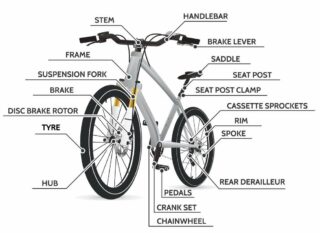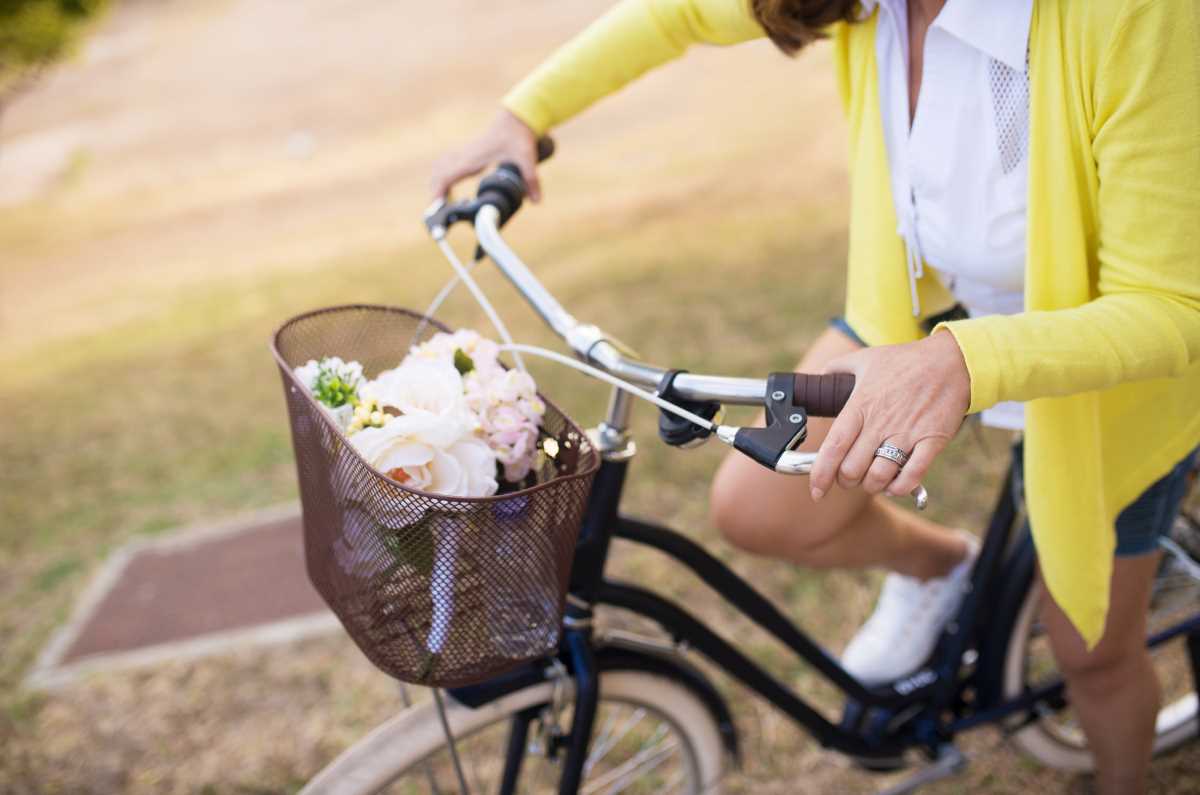Guest blog by hand therapist Catherine Reid, B.App. Sci, (OT), M.Sci (H&UL rehab), MAHTA (As awarded by the AHTA), CHT
The advent of COVID has seen many more people riding their bikes, either for exercise or for their daily commute. It’s a great exercise for the heart and lungs and a low-impact exercise for people with musculoskeletal conditions.
In recognition of the health and environmental benefits of riding a bike, the United Nations declared June 3rd to be World Bicycle Day. Unfortunately, as a hand therapist, I frequently hear patients complain that hand and upper limb pain or weakness limits their ability to ride.
Hand therapists are experts in rehabilitating the upper limb. We understand anatomy and how it relates to everyday activities. We can help determine what’s causing the problem, if it’s due to an injury, illness or activity, and provide appropriate treatment.
Some pain experienced when riding a bike may be due to vibration transmitted up through the bike into the arms or due to the prolonged time or force with which the handlebars are gripped.
If you love to ride but find it a bit painful, here are my top 10 tips for protecting your hands and upper limbs while riding. The best place to start is from the ground up.

1. Tyres
If you’ve ever ridden a bike or billy cart with solids tyres rather than rubber, air-filled, pneumatic tyres, you know what a difference a little air and rubber can make!
Yet even with pneumatic tyres, vibrations or jolting through the handlebars can be painful for people with arthritis or joint injury. Ensuring the tyres on your bike are properly inflated can help reduce stress going up through the arms and into your body. The current thinking in the biking world is that wider tyres with less pressure offer better rolling resistance and comfort.
Wheels for bikes can also vary in stiffness depending on the design and the material they’re made from, so some are better at absorbing shock than others.
2. The frame
If you plan to explore the world and take your bike with you, you need to consider the weight of your bike. Is the weight manageable for you?
And when choosing a bike rack, one mounted on the back of the car might be an easier option than lifting your bike over your head onto the roof of a car. Lower lifts reduce the strain on sore or stiff shoulders.
Carbon fibre and titanium bikes are much lighter than traditional steel-framed bikes but come at a cost.
Another consideration is that the further away your seat is from the handlebars, the more of your weight your arms will be supporting.
3. Shock absorbers
The front fork of a bike can have shock absorbers that reduce the force going up into your arms from uneven terrain while keeping the tyres in contact with the ground for better control. They can be easily adjusted to provide more or less bounce.
4. Stem flexibility
The stem attaches the handlebars to the bike, and the modern stems have pivots, elastomers and moving parts to provide suspension. They may be as effective at smoothing the force from rough terrain as the fork suspension but may be a cheaper option to retrofit to a bike.
5. Handlebar shape
There’s a huge variety of handlebar shapes, which roughly fall into three categories: swept back, drop or flat handlebars. Some of the handlebars offer several different grip positions enabling the rider to vary their grip.
For example, the drop bars enable the rider to use three different positions
- the hooks, the part that curves or drops down, taking most of the weight through the hand;
- the hoods are the rubber covers around the hinges of the levers. For smaller hands, it might be more comfortable holding the levers here, but there’s some loss of strength as the grip is near the hinge and not the end of the lever;
- the third place you can hold a drop bar is on the top of the bar. This gives the rider a more upright position and places the hands in a palm down position, but this is a less anatomically friendly position for the wrist. Placing hands in a palm down position also puts pressure on the nerves in the palm of the hand, which can cause compression neuropathies such as carpal tunnel syndrome or cyclist’s palsy. Carpal tunnel syndrome affects the thumb side of the hand, while Bicycler’s neuropathy affects the little finger side; both conditions cause numbness and tingling in the hand.
6. Handlebar rise and sweep
Handlebar rise is the vertical rise measured from the centre of the bar to the bar end. The handlebar height can be adjusted by raising the stem or by increasing the rise of the handlebars. Increasing the rise changes the body position of the rider to a more upright position, meaning more weight is placed through the saddle, and less weight is placed through the shoulders, wrists and hands. Handlebars can have an upsweep and a backsweep. Sweep is the angle from the stem to the end of the bar either in an upward angle (upsweep) or in a backward angle (backsweep). More upsweep generally places more pressure on the hands, wrist and shoulders, whereas more backsweep places the wrists in a more natural (palms facing) position.
7. Handlebar material
The material the handlebars are made of can affect their ability to reduce or dampen the forces going through them. Carbon fibre and aluminium dampen vibrations better; however, steel and titanium flex. A little bit of flex in a handlebar is a good thing as it absorbs some of the force from bumps in the road.
There’s also a line of handlebars that have a foam-filled core to deaden the vibration through the core.
8. Grips and tapes
Larger grips generally distribute the weight more evenly through the hand. There are lots of commercially available grips, and many can be retrofitted to your bike.
Some change a flat handlebar to provide a vertical grip as well, allowing for a change of hand, wrist and elbow position. This can help reduce hand stiffness and provide rest from pressure on a particular joint or nerve. Tapes can either be gel or cork. The advantage of cork tapes over gel is that they don’t compress over high-pressure areas and are generally more durable.
9. Gloves
Gloves offer added protection from blisters and falls and improve grip. Glove fit should be firm so they don’t bunch up and cause pressure areas. They should also fit firmly around the cuff so water can’t leak in when it’s raining.
Keeping hands warm with waterproof or thermal gloves helps maintain hand dexterity, especially for arthritic hands. Lightweight, breathable summer gloves with wicking ability may be helpful to reduce sweaty palms, which reduce grip.
Some gloves have padding to reduce vibration, which irritates the nerves of the hand, or silicon tips or open tips to improve touch.
Gloves can provide skin protection in the case of a fall or protection for mountain bikers with inbuilt carbon fibre inserts to protect the backs of the hands from trees.
10. Gears and brakes
Traditionally gears fall into 3 categories:
- Twist or grip shifters,
- Trigger shifters, or
- Shimano Total Integration (STI) brake lever shifters.
More recently, digital computerised gear mechanisms have been introduced. They require very little resistance to use, but unfortunately, they’re expensive to retrofit to your bike.
Twist shifters can only be fitted onto straight handlebars and are controlled by rotating the wrist. They’re easier on the fingers and the thumb as wrist motion is used to control the gears. So if you have painful fingers or reduced dexterity, twist gears might be advisable. Twist shifters are known to become stiffer over time, which might put undue strain on the wrist. They also require frequent repositioning of the wrist.
Trigger shifters generally require little force and can be activated with different fingers. To shift gears, the top lever is moved with the fingers, and the bottom lever is moved with the thumb. The benefit of trigger shifters is that the wrist stays in a neutral position. This is helpful if you have tennis elbow as it reduces strain in the muscles at the elbow joint.
STI Brake lever shifters are a combination of the gear shifter and the brake lever on the one fitting. This allows the rider to shift gears without moving their hand from the bars. They’re generally found on touring or racing bikes and can be activated while holding the hoods. They require minimal force to use.
Brakes can either be hydraulic or cable brakes.
Hydraulic brakes are preferable if you have upper limb problems as they take far less force to use. The back pedal (coaster) brakes are less common these days and are generally found on cruiser bikes or kids bikes. They’re worth considering if you have poor eye-hand coordination or poor hand strength. If the levers are too far out from the bars, people with smaller hands have difficulty reaching their fingers around the brake levers, making it difficult to grip forcefully. This can be adjusted with small rubber inserts placed at the hinge end of the brake lever.
Getting your bike tailored to meet your specific needs may just require some minor changes to your existing bike. But sometimes, purchasing a new bike can be more cost-effective. Remember, changing any part of your bike will affect your bike’s fit and may affect your bike’s handling. It’s worth getting your existing bike correctly fitted to you before making too many expensive changes.
If changing your bike isn’t helping, then you need to see a hand therapist to evaluate the cause of the pain and, if needed, provide upper limb exercises, treatments or supportive splints to enable you to keep riding. A hand therapist in your local area can be found on the Australian Hand Therapy website.
Our guest blogger Catherine Reid is an occupational therapist with a Master of Science in Hand and Upper Limb Rehabilitation. She’s a full member of the Australian Hand Therapy Association and works in her private practice Western District Hand Therapy, in Warrnambool, Victoria.
Contact our free national Help Line
Call our nurses if you have questions about managing your pain, musculoskeletal condition, treatment options, mental health issues, COVID-19, telehealth, or accessing services. They’re available weekdays between 9am-5pm on 1800 263 265; email (helpline@msk.org.au) or via Messenger.
More to explore
- The joy of cycling
Musculoskeletal Australia










